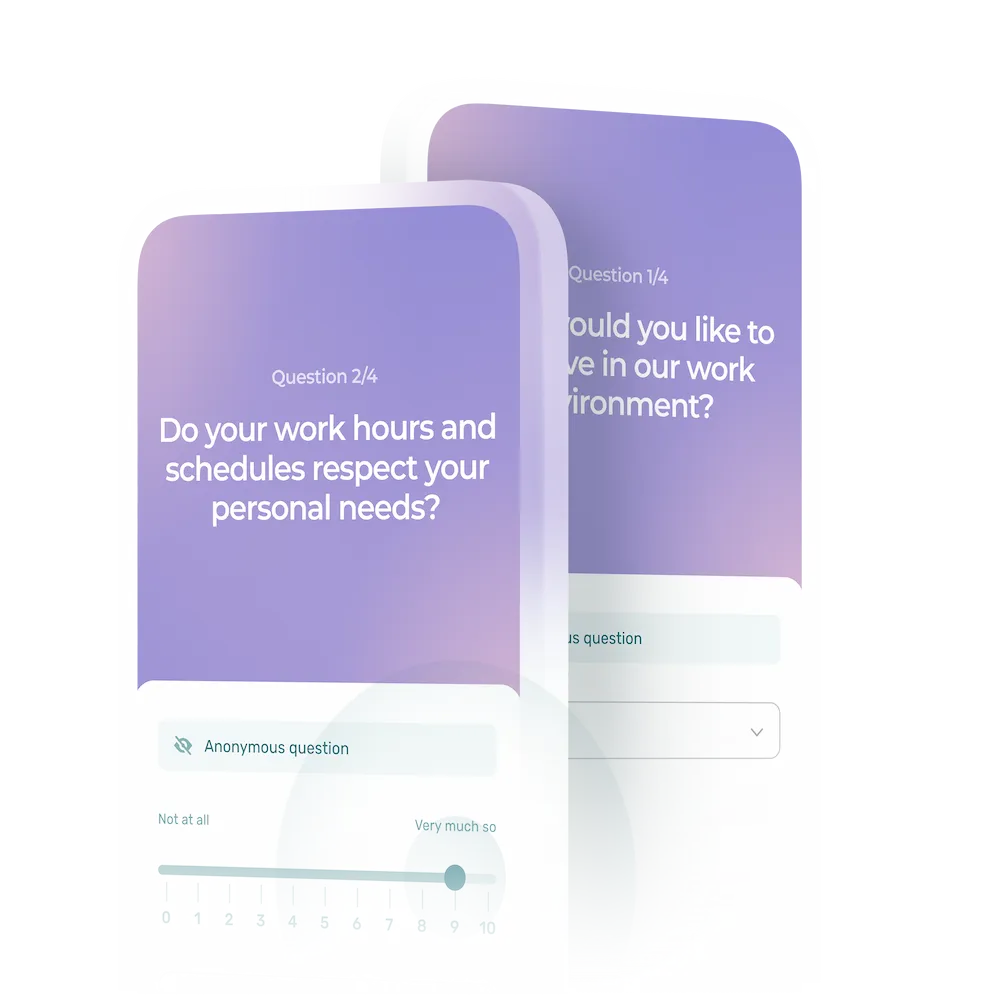Does your company operate in an industry where it is impossible to offer the benefit of telework? Here are 9 alternative ways to give your employees greater flexibility at work.
Over the past 3 years, working from home has become a must for staff recruitment. Nearly all office jobs are now being offered on a telecommuting basis. But what about positions that preclude the possibility of telework?
Restaurants, retail stores, retirement homes, construction companies, supermarkets and other employers require workers to be on site to perform their tasks.
If this is the case for you, not to worry—you can still attract top talent! There are plenty of other ways you can offer your team flexible working arrangements.
This post will show you 9 ways to increase work flexibility at your company, with practical examples.
What Is Work Flexibility?
Let’s start by defining the notion of work flexibility.
The term can refer to any measure a company establishes in order to adapt to fluctuations in economic activity, employee needs and labor market constraints. One of the goals of a flexible arrangement—which takes into account both external and internal realities—is generally to attract and retain talent.
In other words, work flexibility is a form of labor management that helps adapt to the situations of customers, business sectors and employees.
Flexibility and Telework: What Do Employees Really Want?
According to a study by Canada’s Future Skills Centre, 94% of workers who telecommute report wasting less time travelling. The same study also found that 74% of these workers believe that working from home lowers their stress levels and improves their well-being. But what is it that they really love?
Aside from the fact that people like to be at home, it’s fairly easy to see how telework leads to greater flexibility.
First and foremost, teleworking employees enjoy greater control over their own work schedules and can tailor them to their situations and lifestyles (within reason).
This is likely the greatest advantage of teleworking.
9 Ways to Increase Work Flexibility
Would you like to offer your employees greater flexibility, even if they have to be physically present at work? Here are 9 easy and inexpensive ways you can do so.
1. Respect Your Employees’ Availability
Employees share their availability with you, and you take it into account when drawing up the work schedule. This may seem obvious, yet poorly planned shifts are a very common issue on the job market.
An employee might need a day off to attend a graduation ceremony, or to meet personal constraints such as juggling school or family obligations. Whatever the reason for your employee’s unavailability, it’s not acceptable to schedule them for a shift when they’ve clearly told you they are not available.
In fact, according to a survey of 20,000 workers worldwide, respect for employees stands as the single most important behavior for a manager. So you have everything to gain by treating your employees with respect. And this starts with honoring their scheduling requests and their personal time.
🚀 How it improves flexibility: a schedule that respects employees’ availability and time-off requests will allow them to unplug from work, make the most of their free time, and come back to work refreshed, renewed and energized.
2. Allow Employees to Trade Shifts
Allowing employees to swap shifts is a great way to empower your team members as well as demonstrate your trust in them. When an employee is unable to do a shift, they notify the team, and those who are available can volunteer to replace them.
Be sure to establish clear rules for shift swapping, including which shifts can be swapped (and for which roles), whether you allow overtime, etc. For example, if you run a restaurant, you probably don’t want a cook to take a waiter’s shift, and vice versa.
🚀 How it improves flexibility: in addition to freeing you from the logistics of finding a replacement, shift trading allows interested employees to offer to replace others on a voluntary basis. So, you’ll have more motivated replacements!
3. Adopt Rotating Schedules
Rotating schedules are commonplace in industries that require continuous service or care, such as healthcare or emergency services—firefighters come to mind. But the same approach can just as easily be adapted to retail outlets, restaurants, pharmacies, hardware stores, and more!
Rotating shifts mean more flexibility, since they typically vary from week to week or month to month. They can be customized to your own situation. One great way to do so is to give your weekend teams one weekend off every month. This way, you avoid having the same people always working evenings and weekends, for example.
Before you introduce such a change, why not survey your employees and see if they’d be interested in this option?
🚀 How it improves flexibility: even your evening and weekend employees will want to attend events during these times, from the occasional wedding to a children’s party or even just some quality time with family. Rotating schedules free them up on a regular basis, so they can better plan their personal time.
4. Try Split Shifts
The restaurant and hotel industries significantly benefit from split shifts. So why not try them out yourself? If your business experiences fluctuations in visitation or workload over the course of a workday, it’s worth giving this a try.
Does your supermarket put up displays in the morning, then get quiet for a few hours, only to see a surge in traffic at the end of the day? Try bringing in a clerk from 9 a.m. to noon to stock shelves, give them a break between noon and 3 p.m., and have them come back from 3 p.m. to 6 p.m.—and provide outstanding customer service.
🚀 How it improves flexibility: split shifts give employees free time during the day, which can be helpful to student employees who need to do some group work, or employees who want to attend a Zumba class during their lunch break, for example.
5. Put Tools in Place to Make Your Job Easier
You’ve probably heard the expression “work smarter, not harder.” That is exactly what happens when you leverage technology to lighten your workload and that of your managers.
Staff management is a complex and time-consuming endeavour. Opt for tools that save you time, minimize irritation for your team, and adapt to your needs.
- Scheduling software streamlines everything from scheduling to time off and availability management (and much more).
- Time clock software tracks actual hours worked, considerably reducing errors. It can even connect directly to your payroll system.
- Survey software allows you to collect employee feedback on a variety of topics, such as job satisfaction, sense of belonging, workload, and relationships with co-workers.
- Onboarding software helps seamlessly welcome and integrate new employees in addition helping you retain new recruits.
- HR software centralizes your staff records.
Agendrix lets you do all these things in one place. Try it out now—Agendrix is free for up to 21 days! 😉
🚀 How it improves flexibility: equipping managers with the right tools frees them up and gives them more time to be present on the floor, where they can interact with customers and support employees. The entire team will benefit.
6. Have Employees Fill Out an Availability Form
Your employees’ availability may change from time to time, especially if you hire students, who have different courses each semester. Try sending your team an employee availability form regularly, for example, at the start of each season. Make sure you respect your employees’ constraints.
You can also share a time-off request form with them so they can easily make requests when they need to. If you use scheduling software, you can even do all this directly within the tool.
🚀 How it improves flexibility: when your employees are able to regularly share their availability with you, they won’t feel guilty if they suddenly need a schedule change for any reason. This openness on your part will foster their well-being at work and their commitment to your company.
7. Hire On-Call Staff
On-call staff can be a godsend when you need to fill a last-minute shift. Examples include replacing an employee who’s been absent due to illness, increasing staffing during a busy period (for example a 30-person reservation at a restaurant), or even lightening a team’s workload during an event.
This is an attractive option if you’re keeping a close eye on your budget, since on-call employees are only paid for the shifts they work. You enjoy peace of mind knowing they’re available when you need them.
🚀 How it improves flexibility: some employees don’t want a full-time schedule and are willing to be available when needed. This not only helps them save extra money when they have to work, but gives them more free time when they’re not called in.
8. Hire Part-Time Employees
If your company doesn’t already hire part-time employees, know that this solution has multiple benefits. If you feel that your full-time employees are burned out, hiring part-timers can free them from certain shifts and avoid burnout.
Does your full-time team dislike evening or weekend shifts, even with a rotating schedule? Part-time employees are an ideal way to meet this need.
Finally, part-time employees are often more driven and motivated, as they work fewer hours per week. They’ll bring a breath of fresh air into your business, and customer service is sure to benefit. By hiring part-time employees, you’ll also have access to more diverse talent with interesting backgrounds, such as retirees.
🚀 How it improves flexibility: hiring part-time employees frees up some full-time staff, while also enabling you to better plan replacements for vacation periods. Some employees prefer to work just a few hours a week.
9. Give Your Employees Selfcare Days
Everyone needs a break or has an unexpected situation come up from time to time. If you can afford it, give your team the gift of selfcare days.
At Agendrix, we’re entitled to 5 such days per year, which we can use “no questions asked.” It’s so nice to know that if you have a sick child, need to go and recharge your batteries in nature, or urgently have to go to the dentist, you can take the day off without any repercussions whatsoever.
If this option strikes a chord with you, set up a feasible arrangement and provide clear instructions. Whatever you offer, your employees will be very grateful for this benefit.
🚀 How it improves flexibility: selfcare days offer the possibility of not coming in to work if something comes up. It’s the ultimate form of work flexibility.
No Telework, No Problem!
As you can see, there’s no shortage of possibilities when it comes to offering your employees flexibility, even in the absence of telework. The key is to be realistic and to align your company’s needs with those of your employees. Work flexibility can be a win-win all around.
Now it’s your turn to take action!
What Is Work Flexibility?
Work flexibility includes everything a company puts in place to better adapt to the labor market and employees’ needs. Employers who offer workplace flexibility find it easier to attract and retain talent.
What Are the Benefits of Work Flexibility?
Flexible working offers a number of advantages for both companies and employees. Employers who offer flexibility to their team normally observe :
- An increase in their employee retention rate
- Improved job satisfaction and employee well-being
- An increase in employee productivity
- A decrease in their turnover rate
- Reduced absenteeism











